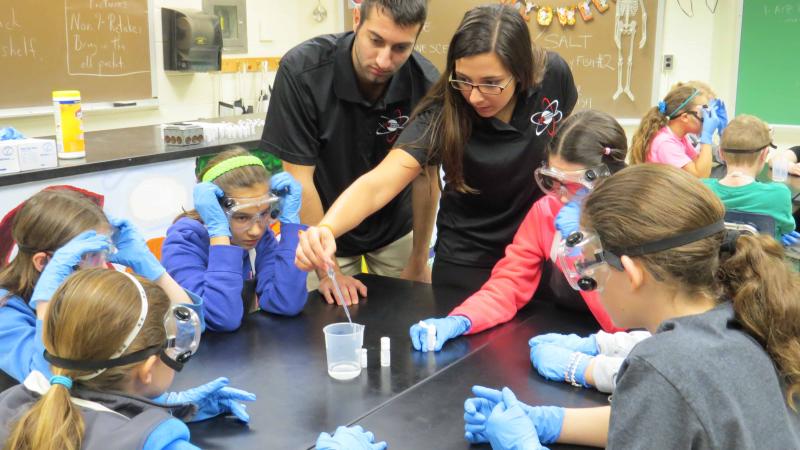February 6, 2015

(In this guest post, School of Science Ambassadors Heili Springsteen (a sophomore mathematics student) and Jeremy Amdur (a sophomore chemistry student) share their experiences -- and a few images -- from their work visiting area middle and high schools to promote interest in science.)
Looking back at middle school and high school, most of us can think of someone who inspired us, or a moment when we realized “this is cool and I might want to do this for the rest of my life.” As Science Ambassadors, our hope is to push students toward that moment of realization, to encourage them that science is, in fact, cool.
Building on the success of the established Engineering Ambassador network, the new Science Ambassador program at Rensselaer Polytechnic Institute has this exact goal in mind. Science Ambassadors visit local schools to deliver presentations that teach younger students things about science that they generally would not have considered or been exposed to in a traditional classroom setting.
As students in the School of Science, the Ambassadors create presentations that focus on the exciting aspects of science – and show that being a scientist is not just sitting alone in a lab all day, but actually something that requires creativity and passion.
One of our presentations focuses on Disney’s Frozen, explaining how the widely acclaimed movie could not have been made without computer scientists and mathematical principles. By looking through a lens of how the movies we all love are made, we’re able to introduce concepts of algorithms and show that math is not limited to simply adding numbers or calculating a tip. Students are then able to try out a simulation for themselves (image below), and it is always fun to see how excited they get when they have the chance to play around with the parameters.
In another presentation, we talk about bioluminescence and how it is not only a natural phenomenon, but something that can be used in our everyday lives. After explaining what bioluminescence is and how it works (image below), we point out that the technology in fireflies could be used to make more environmentally friendly lighting – inviting the students to think about how they might adapt the technology if they were to become scientists.
Yet another presentation puts students in the role of discoverers, as they learn about the Golden Ratio and how it (and the principles behind it) can be seen in everything (image below) from ancient temples like the Parthenon to modern logo design. Instead of simply introducing the concept of ratios, the presentation puts the topic in a new light, framing mathematics as a necessary element of design aesthetic.
For younger students, science is not often something that they consider to be an interesting career choice until later in their academic lives. As such, the Science Ambassador program is a way to open that door to the science world and show that becoming a scientist does not doom them to a life of math problems and test tubes but that, in fact, becoming a scientists paves the way to some of the most exciting opportunities available.



